Sri Jogulamba Bala Brahmeswara Swamy Temple (Telugu: శ్రీ జోగులాంబ బాల బ్రహ్మేశ్వర స్వామ్య్ ఆలయం) also known as Yogulamba (or) Yogamba , is one of the eighteen Shakti peethas (Ashtadasa Sakthi Peethams ) dedicated to Godess Shakti and Lord Shiva. Built around 7th century CE , the temple is located near the banks of river Tungabhadra in Alampur town Mahabubnagar district of Andhra Pradesh. Its also said that Alampur town is the western gateway of Srisailam (one of the 12 jyothrilingas) while other gateways include Siddhavattam – Southern; Tripurantakam – Eastern and Umamaheswaram – Northern ends.
Dakshina Kasi (Kasi of the South): Given its sacred layout and significance, Alampur is also known as Dakshina Kasi . Though several southern shiva temples like Srikalahasthi , Rameswaram also claim to be Dakshina Kasi, several Skandas and Puranas describe spiritual importance of Alampur in resemblance to dakshina kasi. Few comparatives are as follows:
| Description | Northen Kasi | Southern Kasi |
|---|---|---|
| Kasi | Varanasi ( वाराणसी) Uttarpradesh | Alampur (ఆలంపుర్) Andhra Pradesh |
| Moolavirat Shiva (Primary Diety: Lord Shiva) | Viswanath | Brahmeswara Swamy |
| Ammavaru (Godess: Shakti) | Visalakshi | Jogulamba |
| River Bank | Ganga | Tungabhadra |
| No. of Sacred Banks (Ghats & Tirthas) | 64 Ghats & 18 Tirthas | 64 Ghats & 18 Tirthas |
| Adjoining Rivers | Ganga & Jamuna | Krishna & Tungabhadra |
| Confluence Rivers | Varuna & Asi | Nadavati & Eda |
| Gadadhara Swamy | Gadadhra | |
| Gaya | In Papanasini |
Nava Brahma temples of Alampur: Sri Jogulamba Bala Brahmeswara swamy temple being primary abode is also accompanied by 9 shrines popularly known as Nava Brahma temples (Swarga Brahma, Taraka Brahma , Padma Brahma, Bala Brahma, Garuda Brahma, Kumara Brahma, Arka Brahma ,Vira Brahma and Vishwa Brahma. Built by Badami Chalukyas around 6th Century CE, these temple sites preserve archeological remains some housed in nearby museum.
Show details (Nava Brahma temples)
Nava Brahma Temples
This important shrine seems to have been constructed towards the end of the 7th century A.D. There is an inscription above the dwarapalika image, which states that the shrine was constructed by Lokaditya-Ela-Arasa, in honor of the queen of Vinayaditya, called Mahadevi.
Like all other temples except the Taraka Brahma, the Swarga Brahma is a hall temple. The shrine is at the end of the rectangular hall, which is divided into a nave and side aisles by the use of pillars connecting the passage. Like the Kumara Brahma, the Swarga Brahma also has a porch. The panels on the outer walls carry relief figures of the Krishna Lila, Animals, Garuda-nose faces and Matrumurti. The pattern of carving is the same as on the Vishva Brahma temple.
Although there had been relief carvings in Aihole and Pattadakal, the pantheism here shows a passionate enthusiasm for exaltation of human form to divine status. There are Pauranic scenes, loving couples and flying spirits. And in the midst of these are the independent realizations of the gods, by the release into a certain innocence and freer interpretation of the icon beyond the manner of the Chalukyas in the west. One of the new dhyana mantras is a wall sculpture entitled Lingodbhavamurti of Shiva, inset into a tall phallus, with worshipping figures in a rectangular panel from which the lingam is carved. And a truncated figure shows the remains of a dynamic sculpture of shiva as Tripurasuramharamurti. The mobility of the carving skillfully releases energies into the universe with terrifying violence.
Another broken figure is a relief of Gangavatarana, again as a demonstration of the Alampur sculptor’s genius for release of potential power of the gods. A similar sculpture of Shiva involved in the Tandava dance is a heroic image. The frenzy of the movement is caught in the ecstatic moment, by some Viswakarma, realizing himself through the expression of muscular energies into the universal image of dance incarnate.
Shiva is shown in another mood as he stands, pensively, with the gracious bend of his body, almost supplicating Parvati. The Mithuna couples show the sculptor’s sensitiveness to tenderness between the male and the female, through the evocation of desire lurking below the surface of life and evoked here through the woman’s shy withdrawal and the man dragging her by the arm from the natural urge of seduction.
The Swarga Brahma temple has a six pillar porch on the east, the Puranghata pillars being decorated with amalkas. There are horned dwarpals by the doorway. Ganga and Jamuna are symbolically carved on the door-frame with the GarudaNaga motif above. The temple has a curvilinear sikhara of the northern style, with a figure of dancing Shiva carved in the Chaitya window of the Sukanasi.
This temple has remained in worship through the centuries. Therefore, it has often been renovated. The images are a mixture of routine sculptures like Jogulamba, Durga, Narasimha and the Rishis. In the courtyard are images of Mukhalinga, Sahasralinga and Mahishasuramardini. The most vital image is the mother goddess in the small shrine.
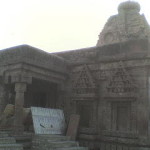
Historical Reference:
Alampur is a veritable mine of Historical sources, pertaining to the Western region of Telangana. More than 70 inscriptions on copper sheets and stone relating to the several Dynasties that ruled over the South from the 7th to the 17th century are available here. Vaidic Dharma, almost lying dormant for some time, due to the flourishing glory of Buddhism and Jainism. Gained Prominence by about the 5th century in North India, under the protective wings of the Gupta Empire. In view of the salvaging efforts, in this direction by the charnpions of Hinduism – Chandra Gupta, Samudra Gupta, and Narendra Gupta – Vaidika Dharma’ established supremacy again through – out Bharat, resulting in the building of majestic temples all over the land.
The program of ‘Dharma Raksha’ initiated by the Gupta rulers, was taken over and fully implemented in the south, by the Badami Chalukyas and Kanchi Pallavas. Fascinating shrines came into existence, on account of the healthy rivalries among the various rulers of the times.
Parameswara Pulakesi, the Chalukya emperor, Vanquished Harshavardhana, the ruler of the Northern region, in a battle and extended his sway to Kanchi in the South and Kalinga in the East During his regime, Alampur rose to prominence as could seen by the temples with superb architectural beauty that were brought into existence After the Chalukyas Balavarma the army general of Dhara Varsha Dhruva Maharaja of the Rashtra Kutas, who conquered the area, not only completed the temple work left un-finished but also built the Mahadwara of the temple.
Subsequently Alampur passed in to the hands of Kalayani Chalukyes of whom Jagadekamalla Trllokyamalla, Bhuvanaikamalla. Tribhuvanamalla, who visited the kshetra donated lands to the temple and the Vidya peetha, (A University of sculpture and architecture) connected to the same Trilochana Muninatha. Vyalasimha , Ekanta Desika, Isana Rasi, Bhuvana Sakti, Kukkuteswara, Dharanindra Rasi, B r a h m a Rasi Bhattaraka. Vitaranendra Rasi, Someswara Rasi, happen to be some of the most erudite Acharyas that adorned the Vidya peetha. Stone images of some of these Acharyas are found in the Main temple. The installation of the image of ‘Kapila Maharshi’ at the place, gives credence to the belief that Sankya Darsana was given a prominent place in the curriculum of studies of the Vidya Peetha.
Kalyana Chalukyas were succeeded by Kalachuryas who is turn gave place to kakatiyas Subsequently Vijayanagar emperors extended their sway over the area, which later came under the rule of the Kutubshahi and then the Asafjahi Dynasty. Idols of Veerabhadra were installed in the temple area, by the Chalukyas. Bijjula Timma Bhupala, who ruled over Alampur, under the suzerainty of the Kutubshahi kings, rendered Murari’s Sanskrit play, ‘ Anargha Ragava’ into a high class Telugu Prabandhas. The Fort wall of the township was built during the regime of Sri Krishna Devaraya, for the protection of the temples.
Architecture:
Chalukya style of architecture predominates in the temple structures, in Alampur, Chariot shaped sanctum, sanctorum a frontal ‘ Antaralam’ leading to Ranga Mantapam with a ‘ Pradakshina ratha surrounding the whole images of Ganga and Yamuna together with Dwara Palakas carved on either side of the entrance, Vimana on the Garbhalaya, witla Amalaka, and Sikhara adorning the same are the chief characteristics of the Chalukyan Architecture.
The temples were built on a rectangular bace, with the entrance facing east. The outer surface of the temple walls are decorated with elegant sculptural desingns. Figuras of Dikpalas are fitted in attractive Deva Koshtas ( niche) and Kosta Panjaras, Sculptural figures pertaining to Mythology are also gracefully carved there on. The walls Presort a picture of Triloka, the upper part adorned with Khechara Midhuna motifs, the middle part with human Midhuna & the lower to the third showing demonic forms carved with grace & elegance.

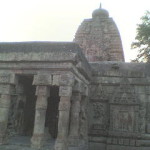
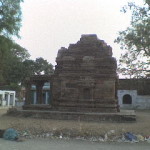
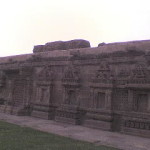
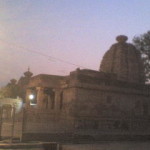
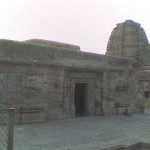
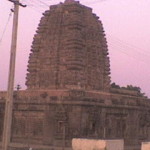
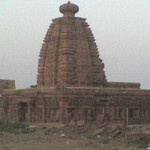
please find complete info of Alampur Jogulamba Temple : https://gotirupati.com/alampur-jogulamba-temple/